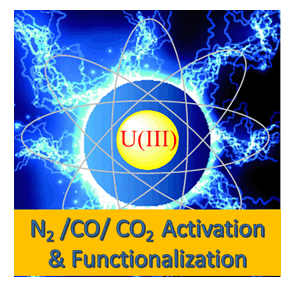| [1] Shi, W. Q.; Zhao, Y. L.; Chai, Z. F. Prog. Chem. 2011, 23, 1478. (石伟群, 赵宇亮, 柴之芳, 化学进展, 2011, 23, 1478.)
[2] Yuan, Y. L.; Shi, W. Q.; Lan, J. H.; Chai, Z. F. Chin. Sci. Bull. 2012, 57, 581. (袁立永, 石伟群, 蓝建慧, 柴之芳, 科学通报, 2012, 57, 581.)
[3] Monreal, M. J.; Diaconescu, P. L. Nat. Chem. 2010, 2, 424.
[4] Jones, C. J. d- and f-Block Chemistry, Polestar Wheatons, Exeter, 2001, p. 86.
[5] Ephritikhine, M. Dalton Trans. 2006, 2501.
[6] Fox, A. R.; Bart, S. C.; Meyer, K.; Cummins, C. C. Nature 2008, 455, 341.
[7] Liddle, S. P. Angew. Chem., Int. Ed. 2015, 54, 30.
[8] Fortier, S.; Hayton, T. W. Coord. Chem. Rev. 2010, 254, 197.
[9] Altmaier, M.; Gaona, X.; Fanghänel, T. Chem. Rev. 2013, 113, 901.
[10] Loiseau. T.; Mihalcea, I.; Henry, N.; Volkringer, C. Coord. Chem. Rev. 2014, 266~267, 69.
[11] Gardner, B. M.; Liddle, S. T. Eur. J. Inorg. Chem. 2013, 3753.
[12] Jones, M. B.; Gaunt, A. J. Chem. Rev. 2013, 113, 1137.
[13] Arnold, P. L.; McMullon, M. W.; Rieb, J.; Kuhn, F. E. Angew. Chem., Int. Ed. 2014, 53, 2.
[14] Karmel, I. S. R.; Fridman, N.; Tamm, M.; Eisen, M. S. J. Am. Chem. Soc. 2014, 136, 17180.
[15] Karmel, I. S. R.; Fridman, N.; Eisen, M. S. Organometallics 2015, 34, 636.
[16] Ossola, F.; Zanella, P.; Ugo, P.; Seeber, R. Inorg. Chim. Acta 1988, 147, 123.
[17] Avens, L. R.; Barnhart, D. M.; Burns, C. J.; McKee, S. D.; Smith, W. H. Inorg. Chem. 1994, 33, 4245.
[18] Morris, D. E.; Re, R. E. D.; Jantunen, K. C.; Castro-Rodriguez, I.; Kiplinger, J. L. Organometallics 2004, 23, 5142.
[19] Haber, F. DE 229126, 1909.
[20] Roussel, P.; Hitchcock, P. B.; Tinker, N.; Scott, P. Chem. Commun. 1996, 17, 2053.
[21] Odom, A. L.; Arnold, P. L.; Cummins, C. C. J. Am. Chem. Soc. 1998, 120, 5836.
[22] Cloke, F. G. N.; Hitchcock, P. B.; J. Am. Chem. Soc. 2002, 124, 9352.
[23] Evans, W. J.; Kozimor, S. A.; Ziller, J. W. J. Am. Chem. Soc. 2003, 125, 14264.
[24] Mansell, S. M.; Kaltsoyannis, N.; Arnold, P. L. J. Am. Chem.Soc. 2011, 133, 9036.
[25] Khodakov, A. Y.; Chu, W.; Fongarland, P. Chem. Rev. 2007, 107, 1692.
[26] Brennan, J. G.; Andersen, R. A.; Robbins, J. L. J. Am. Chem. Soc. 1986, 108, 335.
[27] Parry, J.; Carmona, E.; Coles, S.; Hursthouse, M. J. Am. Chem. Soc. 1995, 117, 2649.
[28] Castro-Rodriguez, I.; Meyer, K. J. Am. Chem. Soc. 2005, 127, 11242.
[29] Summerscales, O. T.; Cloke, F. G. N.; Hitchcock, P. B.; Green, J. C.; Hazari, N. Science 2006, 311, 829.
[30] Summerscales, O. T.; Cloke, F. G. N.; Hitchcock, P. B.; Green, J. C.; Hazari, N. J. Am. Chem. Soc. 2006, 128, 9602.
[31] Arnold, P. L.; Turner, Z. R.; Bellabarba, R. M.; Tooze, R. P. Chem. Sci. 2011, 2, 77.
[32] Gardner, B. M.; Stewart, J. C.; Davis, A. L.; McMaster, L. W.; Blake, A. J.; Liddle, S. T. Proc. Natl. Acad. Sci. 2012, 109, 9265.
[33] Gibson, D. H. Chem. Rev. 1996, 96, 2063.
[34] Fujita, E. Coord. Chem. Rev. 1999, 185-6, 373.
[35] Keith, D. W. Science 2009, 325, 1654.
[36] Solomon, S.; Plattner, G. K.; Knutti, R.; Friedlingstein, P. Proc. Natl. Acad. Sci. 2009, 106, 1704.
[37] Natrajan, L.; Pecaut, J.; Mazzanti, M. Dalton Trans. 2006, 1002.
[38] Andrews, P. C.; Beck, T.; Forsyth, C. M.; Fraser, B. H.; Junk, P. C.; Massi, M.; Roesky, P. W. Dalton Trans. 2007, 5651.
[39] Castro-Rodriguez, I.; Nakai, H.; Zakharov, L. N.; Rheingold, A. L.; Meyer, K. Science 2004, 305, 1757.
[40] Lam, O. P.; Bart, S. C.; Kameo, H.; Heinemann, F. W.; Meyer, K. Chem. Commun. 2010, 46, 3137.
[41] Castro, L.; Lam, O. P.; Bart, S. C.; Meyer, K.; Maron, L. Organometallics 2010, 29, 5504.
[42] Schmidt, A. C.; Nizovtsev, A. V.; Scheurer, A.; Heinemann, F. W.; Meyer, K. Chem. Commun. 2012, 48, 8634.
[43] Matson, E. M.; Forrest, W. P.; Fanwick, P. E.; Bart, S. C. J. Am. Chem. Soc. 2011, 133, 4948.
[44] Kahan, R. J.; Cloke, F. G. N.; Roea, S. M.; Niefb, F. New J. Chem. 2015, 39, 7602.
[45] Zhang, S. D.; Ding, Y. Q.; Gu, Z. M.; Wang, X. Y.; Ye, G. A.; Wang, X. L.; Shen, X. H.; Qin, Z.; Zhao, Y. L.; Shi, Q. L.; Li, J. Y. Chemistry Online 2014, 77, 660. (张生栋, 丁有钱, 顾忠茂, 王祥云, 叶国安, 汪小琳, 沈兴海, 秦芝, 赵宇亮, 师全林, 李金英, 化学通报, 2014, 77, 660.)
[46] Xiao, H.; Hu, H. S.; Schwarz, W. H. E.; Li, J. J. Phys. Chem. A 2010, 114, 8837.
[47] Wang, Y. L.; Liu, Z. Y.; Li, Y. X.; Bai, Z. L.; Liu, W.; Wang, Y. X.; Xu, X. M.; Xiao, C. L.; Sheng, D. P.; Diwu, J.; Su, J.; Chai, Z .F.; Albrecht-Schmitt, T. E.; Wang, S. A. J. Am. Chem. Soc. 2015, 137, 6144.
[48] Liu, W. J. Mol. Phys. 2010, 108, 1679.
[49] Hu, S. W.; Wang, X. Y.; Chu, T. W.; Liu, X. Q. J. Phys. Chem. A 2009, 113, 9243.
[50] Zhang, L.; Hou, G. H.; Zi, G. F.; Ding, W. J.; Walter, M. D. J. Am. Chem. Soc. 2016, 138, 5130.
[51] Ding, W. J.; Fang, W. H.; Chai, Z. F.; Wang, D. Q. J. Chem. Theory Comput. 2012, 8, 3605.
[52] Ding, W. J.; Wang, D. Q. Organometallics 2014, 33, 7007.
[53] Wang, D.-Q.; Gunsteren, W. F. V. Prog. Chem. 2011, 23, 1566. (王东琪, Gunsteren W F V., 化学进展, 2011, 23, 1566.) |
